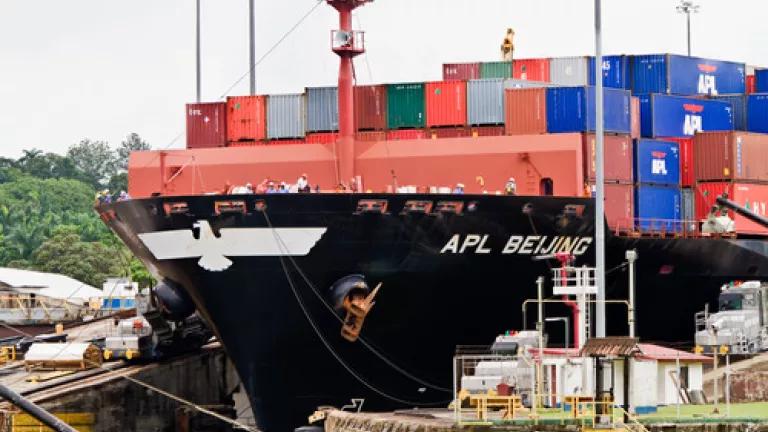
The holidays finally provided a chance to catch up on some reading, including a remarkable book from 2006 called The Box: How the Shipping Container Made the World Smaller and the World Economy Bigger, by Marc Levinson. I figured this was appropriate during one of the biggest sales periods of the year, when many receive gifts that are at the tail end of longer-than-ever global supply chains.
Containerization of cargo transformed the world, as Levinson reminds us off the bat: "Before the container, transporting goods was expensive--so expensive that it did not pay to ship many things halfway across the country, much less halfway around the world." But now "[T]ransportation has become so efficient that for many purposes, freight costs do not much affect economic decisions." One could argue with justification that this would be different if externalities such as carbon pollution were accounted for, but on the other hand containerization has also made hauling a ton of freight much more energy-efficient. Fuel saved, after all, is money saved.
A key figure behind all of this was Malcom McLean, a serial entrepreneur whose fingerprints you can still see on the freight system when you spot a semi labeled McLean on a highway next time you're traveling. His first company created the Ideal X in 1956, the first-of-its kind container ship loaded with specially made boxes. The ship was retrofitted to hold them and the cranes at the loading and receiving ends (Newark, NJ and Houston, TX respectively) were tailor-made too. Costs for loading cargo at that time were nearly $6 per ton, while the Ideal X drove the cost down to a mere 15.8 cents a ton!
Fast forward ten years and we find the ripple effects of this remarkable cost differential affecting the economic fate of cities. Those that adapted and expanded in preparation for a future of container shipping thrived, while those that did not were left behind:
Behind this frenzied expansion of long-neglected ports was the emergence of an entirely new line of thought about economic growth. Manufacturing was almost universally regarded as the bedrock of a healthy local economy in the 1960s, and much of the value of a port, aside from jobs on the docks, was that transportation-conscious manufacturers could locate nearby. As early as 1966, though, public officials in Seattle were sensing that their remote city, with little industry, might be able to develop a new economy based on distribution rather than on factories..."
Ports, rail, trucking, all of it changed in the wake of containerization, with dramatic expansion in the former as you can see if you visit Long Beach, Seattle, or Rotterdam (I've toured the amazingly huge facilities at the Port of Rotterdam). And shipping is the driver here -- according to the International Maritime Organization more than 90 percent of international trade travels by sea. And while in the 1950s and 1960s ships held hundreds of containers, they now hold thousands. And a new wave has already made its way through the trading system:
The economies of scale were so clear, and so large, that in 1988 ship lines began buying vessels too wide to fit through the Panama Canal. These so-called Post-Panamax ships needed deeper water and longer piers than many ports could offer. They were uneconomic to run on most of the world's shipping lanes. They offered no flexibility, but they could do one thing very well. On a busy route between two large, deep harbors such as Hong Kong, China and Los Angeles or Singapore and Rotterdam, they could sail back and fort, with a brief stop at each end, moving freight more cheaply than any other vehicles ever built. By the start of the twenty-first century, ship lines were ordering vessels able to carry 10,000 20-foot containers, or 5,000 standard 40-footers, and even bigger ships were on the drawing boards.
I went to high school in Panama, and have actually been through the Canal (which inlcudes locks like the one pictured below with a container ship coming through, courtesy of DeVerm).
It is an engineering wonder, and so large it nearly defies description (the gates for the locks rest on ball bearings the size of elephants). And the post-Panamax ships, several football fields long, are truly incredible. A century after its opening -- 2014 -- a massive project to expand the Canal to accommodate many such ships will be complete. World trade will be profoundly affected, and so will port cities along the east and west coasts (eastern ports should benefit as more Asian trade takes the Canal route to U.S. consumers as opposed to settling for congested west coast ports).
Okay, but what about the environment? The good news is that innovative, clean technologies and techniques are being invented to protect our natural resources from the burgeoning volume of global trade. I wrote about some of the innovations a few years ago in the pages of In Business magazine. And colleagues at the Environmental Defense Fund published a report in 2010 cleverly named "The Good Haul" profiling 27 of these most interesting such projects, in 10 important categories:
- Port and corridor cleanup plans (including in the aforementioned Ports of Long Beach and Seattle);
- Shoreside power;
- Ship cleanup;
- Coastal shipping;
- Rail yard and port cargo handling equipment;
- Diesel engine emissions reductions and incentives;
- Truck tolling;
- Truck stop electrification;
- Logistics; and
- On-the-horizon technologies for rail, port and maritime (such as an entirely battery-powered locomotive).
Despite the doldrums the global economy is struggling through right now, freight is projected to increase rapidly in the coming decades as containerization and the intermodal connections (ship-rail-truck) that facilitate it continue revolutionizing the world. I'll be reading and writing more about it in these pages, and hope you will work with us here at NRDC to make sure that we chart a clean, energy-efficient and environmentally responsible course ahead.
